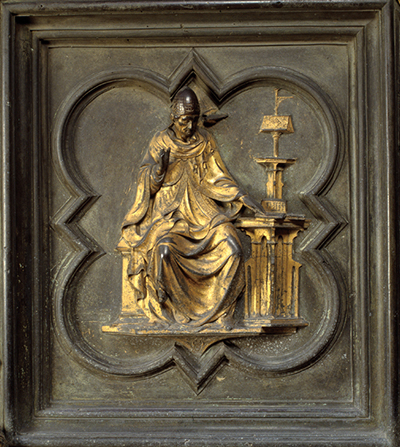Pope Gregory I is sometimes known as Gregory the Great and served as Pope from the 3rd of September 590 to the 12th of March 604.
This particular Pope is celebrated with feasting on the 3rd of September for those in the Latin Church and the 12th of March for those in Eastern Churches, Anglicanism and Lutheranism.
Gregory is considered by many as starting medieval spirituality through literature, much of which has survived to the present day. His impact through written word clearly left a significant impact both at that time, and also in the centuries that followed.
Lorenzo Ghiberti used the same flourished outline for this panel as used by Andrea Pisano for the doors that he produced around a century earlier. As a general rule, when new doors were produced, the older ones would be moved over to a less prominent area of the Florence Baptistery.
Indeed Ghiberti's own doors were moved on occasions, with the most sensible decision being to place them indoors after centuries of damage from Italian city pollution which lost some of the original beauty of these sculptured pieces.
This artwork has perhaps the most gilt remaining from the original mould as any in the series of the north doors. The impact of city pollution is well known, but much has occurred purely from the centuries that have passed since the masters of the Early Renaissance put their careers together. Many frescoes, sculptures and drawings from this period have been either significantly damaged or perhaps even lost to the generations that followed.




